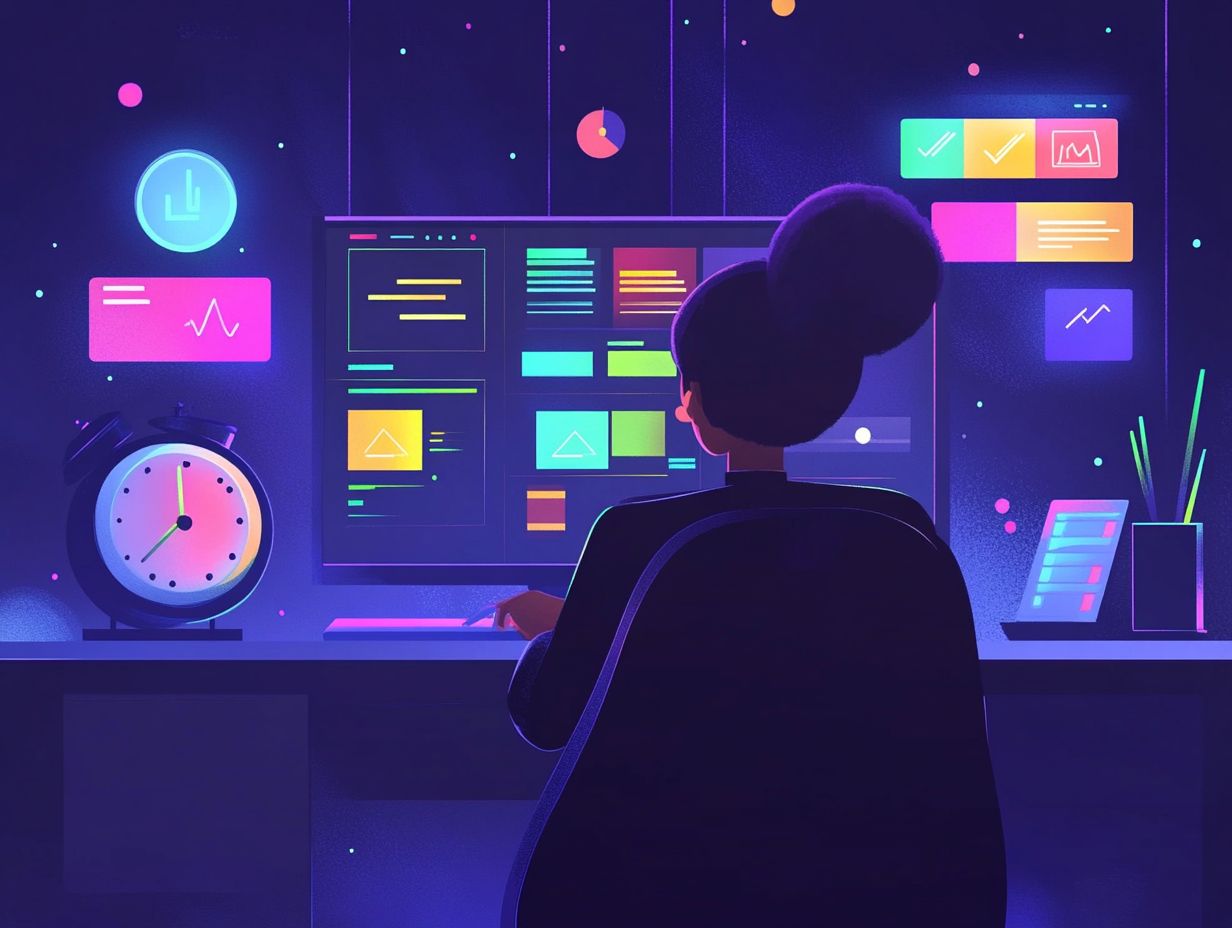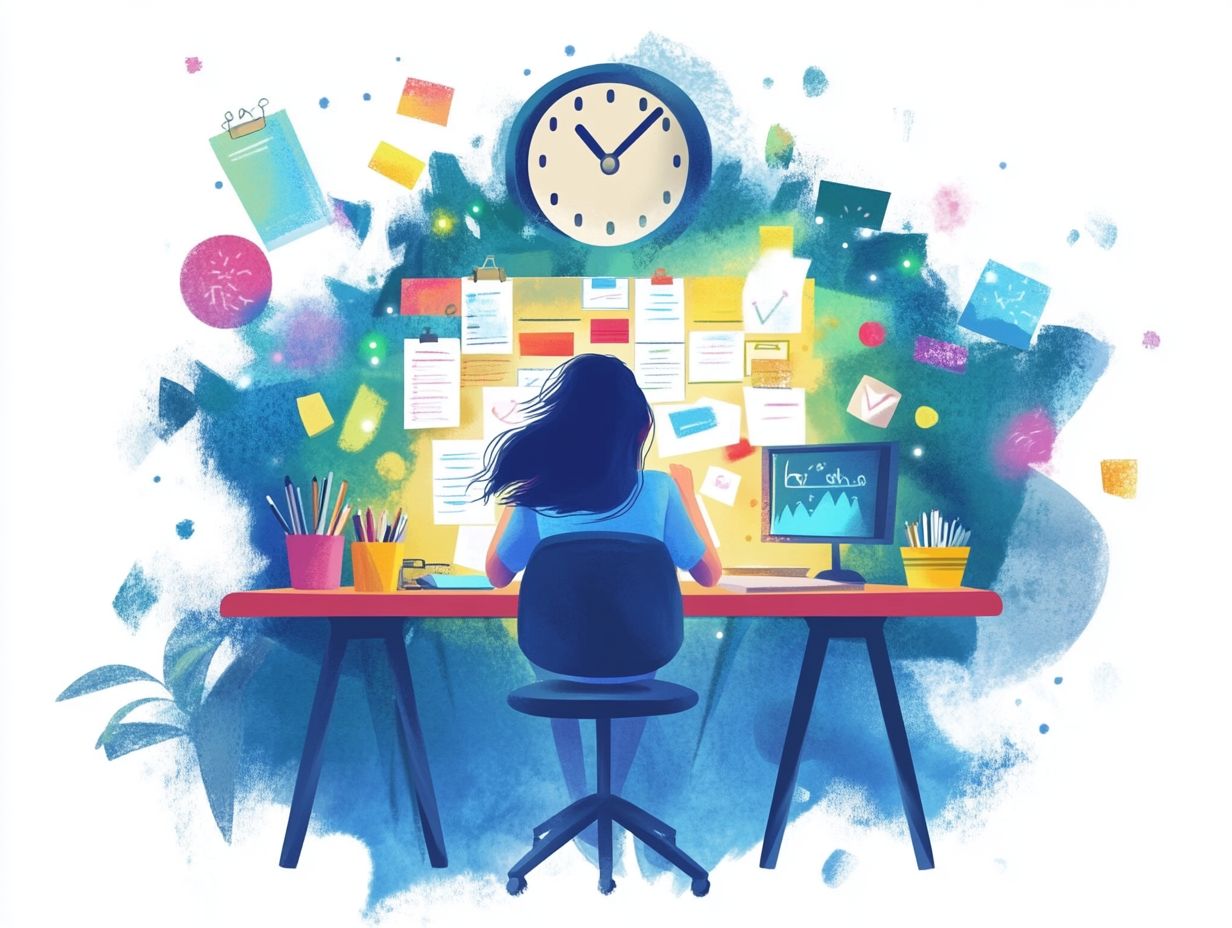Using Gamification to Overcome Procrastination
Procrastination is a challenge that many people face, often driven by distractions and the burden of overwhelming tasks. Understanding the underlying causes is your first step towards meaningful change.
Consider the innovative approach of gamification transforming tasks into engaging, game-like experiences. Explore straightforward techniques like point systems and challenges that can elevate your productivity and help you craft a personalized gamification plan.
Get ready to defeat procrastination and take back your time like never before!
Contents
- Key Takeaways:
- Understanding Procrastination
- The Role of Gamification in Overcoming Procrastination
- Examples of Gamification Techniques for Productivity
- Creating a Gamification Plan for Overcoming Procrastination
- Tips for Successful Implementation of Gamification
- Frequently Asked Questions
- What is gamification and how can it help me overcome procrastination?
- How can I use gamification to manage my time more effectively?
- Are there specific gamification tools or techniques that are effective for overcoming procrastination?
- Can gamification help me stay motivated and focused on long-term goals?
- Is gamification effective for everyone, or only for certain types of people?
- How do I get started with using gamification to overcome procrastination?
Key Takeaways:

- Understand why you procrastinate: identifying the root causes is the first step towards overcoming it.
- Gamification can be a powerful tool for beating procrastination by making tasks more engaging and rewarding.
- Create a personalized gamification plan: identify your specific goals and tasks, and design a system that works for you to increase productivity.
Understanding Procrastination
Procrastination is a complex problem that affects countless individuals, often stemming from a lack of motivation and ineffective time management. Grasping the definition and root causes of procrastination is crucial for your personal development and productivity enhancement.
It can be a formidable obstacle to your growth and achieving weekly goals, introducing negative elements into your daily routine. By recognizing these patterns, you can take charge and tackle the underlying factors fueling procrastination.
Definition and Causes
Procrastination is the act of delaying or postponing tasks, often leading to stress and diminished productivity. This behavior can arise from emotional connections and underlying psychological factors.
You may notice it manifesting in forms ranging from simple disorganization to more complex avoidance strategies, driven by fears of failure or perfectionism. For many, the motivational factors that should spark action are overshadowed by emotional barriers like anxiety or self-doubt.
Gaining insight into these psychological triggers can clarify the reasons behind procrastination, enabling you to address these habits more effectively. By exploring different definitions and perspectives, you can begin to understand how your personal history and emotional experiences shape your approach to tasks.
The Role of Gamification in Overcoming Procrastination
Gamification means turning tasks into games to make them more fun. It integrates game-design elements into non-game contexts, serving as a powerful tool to combat procrastination.
This approach enhances productivity and motivation, transforming your experiences into engaging adventures through positive reinforcement techniques. It taps into your intrinsic motivation, fostering a sense of accomplishment.
What is Gamification?
Gamification weaves game mechanics and design elements into non-gaming environments to elevate user engagement and productivity. This innovative approach uses techniques like point systems, leaderboards, challenges, and rewards to instill a sense of competition and achievement.
Its reach extends across various sectors, from education where it enriches learning experiences to healthcare, encouraging healthier behaviors, and into corporate environments, amplifying employee performance and satisfaction.
By tapping into both intrinsic and extrinsic motivation, gamification creates an engaging atmosphere that inspires you to set and achieve personal goals, leading to continuous self-improvement and a profound sense of accomplishment.
How it Can Help with Procrastination

Adding game-like elements to tasks can be your secret weapon against procrastination, transforming mundane activities into engaging challenges that ignite your motivation and promote consistent progress. With the right productivity apps and a sprinkle of rewarding you for your efforts, you can turn your to-do list into an exciting game.
These tools often feature point systems that reward you for completing tasks. This makes even the dullest duties feel like an exhilarating game.
As you earn points for your achievements, you can visually track your progress. This fosters a sense of accomplishment that propels you forward. Many productivity applications also offer enticing external rewards, like badges or virtual currency, to further incentivize your efforts.
Fun elements heighten your engagement and deepen your connection to your goals, ultimately helping you to conquer procrastination with ease.
Examples of Gamification Techniques for Productivity
You can explore a variety of gamification techniques designed to elevate productivity, such as points systems, challenges, and leaderboards. These elements foster a spirit of friendly competition and motivate you to achieve your goals with greater effectiveness.
Points and Rewards Systems
Points and rewards systems are essential elements of adding game-like elements, enabling you to earn points for completing tasks that can be exchanged for tangible rewards. This method rewards you when you complete tasks and allows you to trade points for real-life rewards.
This framework leverages both intrinsic and extrinsic motivation, elevating your overall engagement. When you receive points for achieving daily goals, it instills a sense of accomplishment that enhances your commitment to ongoing activities.
In your daily life, these systems can be applied in a variety of effective ways. Think about fitness apps that award points for steps taken or exercises completed, or educational platforms that offer badges for academic achievements. This approach cultivates a sense of competition and inspires you to push your limits, transforming mundane tasks into something more rewarding and enjoyable.
Challenges and Leaderboards
Incorporating challenges and leaderboards can significantly elevate your engagement and motivation, creating a competitive atmosphere that encourages you to push your limits and achieve more. This dynamic harnesses the principles of gamification, transforming tasks into something that feels more like a game rather than a mundane chore.
By establishing clearly defined targets and tracking progress publicly, you cultivate a sense of ownership over your achievements. The excitement of competing for the top spot on a leaderboard ignites a friendly rivalry that can lead to enhanced performance. As you observe the accomplishments of your peers, you re likely to feel inspired to reach new heights yourself.
These structures amplify productivity and foster a supportive community where teamwork flourishes, ultimately enhancing your overall satisfaction and driving better results.
Creating a Gamification Plan for Overcoming Procrastination
Crafting a gamification plan to conquer procrastination requires you to set clear, achievable goals, establish a daily routine, and implement effective progress-tracking methods. This approach ensures you remain consistently engaged and motivated on your journey toward personal growth.
Start your gamification journey today and watch procrastination fade away!
Identifying Goals and Tasks

Identifying specific goals and tasks is essential for crafting a gamification plan that resonates with you. This approach allows you to concentrate your efforts on meaningful objectives that enhance your daily routine and boost your overall productivity.
When you clarify what you want to achieve, you lay the groundwork for completing tasks and helping you grow. By breaking your goals down into manageable steps, you can easily track your progress and celebrate small victories, which is motivating. This roadmap makes it easier for you to focus on what really matters!
Having defined benchmarks enables you to pinpoint areas needing improvement, leading to a more efficient use of your time and resources. This sense of purpose drives you forward in your personal and professional pursuits, making each step feel like a victory.
Designing a System that Works for You
Designing a gamification system that resonates with you requires a personalized approach. Consider your unique motivations, daily routines, and specific areas ripe for engagement and improvement.
By pinpointing what genuinely inspires and excites you, you can create an environment that nurtures your growth. Customizing game mechanics such as rewards, challenges, and ways to get regular updates on your progress to align with your aspirations fosters a sense of ownership and accountability.
This tailored experience enhances your engagement and transforms the journey toward self-improvement into something both productive and enjoyable. Keep checking your progress to stay on top of your goals!
Tips for Successful Implementation of Gamification
To successfully implement gamification in your daily life, you need a thoughtful strategy that balances motivation with sustainability. This way, you can stay engaged in your productivity efforts without risking burnout.
It’s all about finding that sweet spot where enjoyment meets achievement.
Maintaining Motivation and Avoiding Burnout
Maintaining motivation while avoiding burnout is crucial when implementing gamification. You ll want to keep an eye on your engagement levels and be ready to adjust your system as needed.
To create a sustainable atmosphere, adopting several effective strategies is essential. One powerful approach is to set achievable milestones that provide a sense of progress without overwhelming you.
Incorporating rewards that celebrate small victories can keep your spirits high and boost productivity, fostering an environment where you feel valued and engaged. Facilitating regular feedback allows you to recalibrate your goals based on your performance.
These practices enhance your motivation and promote a healthier balance that helps mitigate the risks of burnout.
Adjusting as Needed
Adjusting your approach is essential to the gamification process, allowing you to refine your systems and ensure ongoing productivity and personal growth.
When you embrace flexibility within your gamification systems, you enable yourself to respond dynamically to changing circumstances and evolving goals. This adaptability not only sustains your motivation but also boosts your overall engagement.
Recalibrate points and rewards. Adjust challenges based on your milestones. Those who regularly assess and tweak their strategies are likely to see significant improvements in productivity levels, as the gamified elements remain relevant and inspiring.
Ultimately, this iterative approach shapes a personalized learning journey and fosters resilience a crucial ingredient for achieving long-term success.
Start implementing gamification strategies today to enhance your productivity and achieve your goals!
Frequently Asked Questions

What is gamification and how can it help me overcome procrastination?
Gamification uses game-like elements in everyday tasks to make them more engaging. It helps you break down tasks and feel a sense of accomplishment, keeping you focused and motivated.
How can I use gamification to manage my time more effectively?
Set specific goals and deadlines for your tasks. Use rewards to track your progress and motivate yourself to meet those deadlines.
Are there specific gamification tools or techniques that are effective for overcoming procrastination?
Yes! You can use techniques like a point system, a virtual avatar to represent your progress, or a leaderboard to compare your performance with others.
Can gamification help me stay motivated and focused on long-term goals?
Absolutely! Gamification helps you break big goals into smaller, manageable tasks. By rewarding yourself for completing these tasks, you stay motivated and on track.
Is gamification effective for everyone, or only for certain types of people?
Gamification works for anyone wanting to overcome procrastination. It appeals to those who enjoy games and competition, as well as those who prefer visual methods of task management.
How do I get started with using gamification to overcome procrastination?
Getting started with gamification is simple and fun! Create a system of rewards for yourself or try one of the many gamification apps available. Make sure to set clear goals and find a system that suits you.






